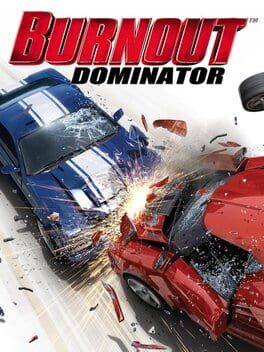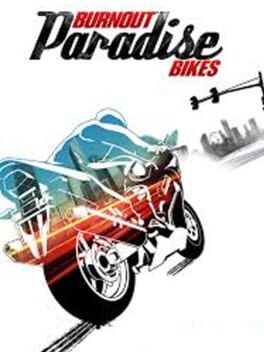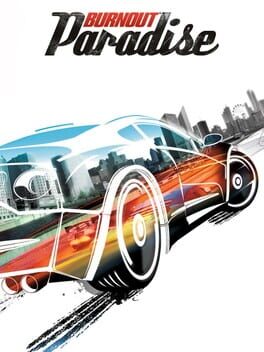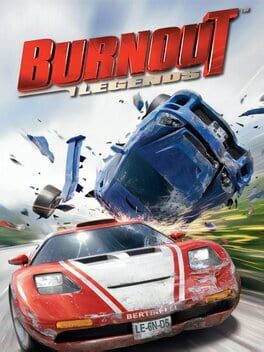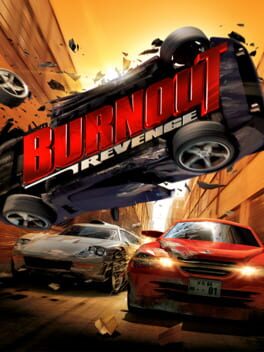

Burnout Dominator is an installment of the Burnout series for the PlayStation 2 and the PlayStation Portable systems. The game is mainly focused on returned Burnouts feature - draining a complete boost meter without stopping wich was last seen in Burnout 2: Point of Impact. With return of Burnouts feature there were four new game modes added including Maniac Mode (players need to drive dangerously to get highest scores by earning drifts, air, oncoming and near misses. Chaining Burnouts in this mode increases the score multiplier), Drift Challenge (in this mode player need to obtain as many feet of drifting as possible. Chaining Burnouts also increases the score multiplier here), Near Miss Challenge (same as Drift Challenge, but player needs to score near miss bonuses), Burnout Challenge (also same as Drift Challenge, but focusing on obtaining Burnouts score). However, some options have been removed from the game - for instance Burnout Dominator doesn't feature Crash Mode, there is also no Traffic Checking Mode and Online Multiplayer. But PSP version features Burnout HQ where you can upload you score and download new track. The game consists of 12 different tracks, in 8 different real world locations. Each track has a forward and a reverse configuration.
Also in series
Reviews View More
The signature shortcut system replaces the signature takedown system. This seems like a good idea on paper but with this game's weird takedown physics and the placement of shortcuts themselves means you will never get any unless you actively set yourself up for it.
Both the car and track designs are horrid, tracks have blind turns and are worsened by the floaty collision physics of the game. Their wide roads, extra routes and anormal turns create a lack of combat and risk. The car designs are cartoony and exaggerated, commisioned to another studio then touched up by EA UK. You need to take a look at them yourself.
Besides like 5 versions of Girlfriend, The music is fine. It's a mix of Paradise's music along with other licensed tracks. Nothing of note.
Two things really good about this game are the online and the maniac game mode. In maniac, you do every stunt you can in order to rack up points while your boost chain acts as a multiplier. Then there's the online. It's damn fun, especially team road rage events.
Going through a development hell, it came out of it playing safe. Get Revenge instead, if you can.
★★★☆
“NOT A DRIVING GAME. THANK GOD.”
Genre is a tricky thing. In videogames, genre has a status which is unmatched in any other creative form. Every game review site divides the games by console and then by genre. We know that an RPG will sell best in Japan, and an FPS will do better in North America. Games are pitched and funded according to genre, and when the market is flush with games of a particular genre, it is perceived that there is a problem. When a console launches, it needs one game from each major genre.
The problem is that in videogames, genre is bullstuff. It can stop a good game from getting good reviews. It can even stop you from enjoying a good game. Burnout: Dominator is a game which suffers from the industry’s obsession with genre.
A number of people, including me, were disappointed when they played their second Zelda game. Imagine you played Ocarina of Time and then Twilight Princess. You would be thinking to yourself, ‘Wait, the plot is exactly the same. The moves are exactly the same. The equipment and locations are the same. This is the same game.’ A person who thinks this is a person who mistakes Zelda for an action adventure game. But Zelda is a puzzle game, and the puzzles do change from one Zelda game to the next – at least as much as they did between Bomberman and Bomberman II. The sword, the shield, the evil wizard and princess all make Zelda seem like it is related to Dragon Quest, but they are all completely irrelevant to the design, and to your enjoyment of the game.
Just like Zelda is filed under ‘Action Adventure’ at Gamespot, Burnout: Dominator is filed in the ‘Driving’ or ‘Racing’ section of every magazine, every website and every game store. It has cars, it has tracks, it has races, and it should be pretty obvious to everyone that it is a racing game. Only it isn’t.
Dominator lets you know that it isn’t a racing game in subtle ways. For example, in Dominator, as in every other Burnout game, if you are holding the d-pad towards the right when you slam into the outside edge of a right turn, you don’t crash and explode. Instead, your car slows down and gently bumps towards the correct direction. So long as you know whether the road is heading left or right, you are not penalized for missing the corners. Of course, you lose some time when this happens. But as in other Burnout games, the dramatic rubber-banding AI means that a loss of time is not actually a penalty. Very few of the events even record your time.
There is only one penalty for missing a turn. The penalty is this: your turbo-boost meter turns from blue to orange. As long as the meter stays blue, you can chain an unlimited number of boosts together. Drift uninterrupted around a corner, and the meter will stay blue. The second time you do this, you start to accrue double points. Then triple, then quadruple. The moment you screw up a corner, you lose your combo multiplier. This may sound familiar to you if you play games of a certain genre, though I’d guess that most buyers of Dominator have never done so.
The biggest hint as to what kind of game Dominator is comes from the titular gameplay mode. The ‘Dominator’ mode awards a score based mainly on how many turbo boosts you can chain together. The final, game-ending mission is itself a Dominator event which requires you to boost continuously for three laps to rack up the required score. If you break your boost chain even once during the three laps, you lose.
This is where Dominator differs from previous Burnout games. To win a race, no matter which track you are on and no matter which car you are driving, you must chain one boost into another. As long as you corner well and drive on the wrong side of the road, you can boost forever and your score multiplier will increase. Dominator has three separate mission types which essentially measure your ability to generate boost combos. It has two race modes where you always win if you continuously chain boosts. It has a single timed mode which requires you to score a number of boost combos, and finally it retains the ‘Road Rage’ mode which asks you to smash opposing cars. This last mode is the one aberration in a game which is otherwise a completely pure rhythm game.
Like Osu! Tatakae! Ouendan! Or like Dance Dance Revolution. The circuits are songs, and the corners are beats or notes in the melody. To fully appreciate this metaphor, of course, you will need to switch off the terrible ‘EA Traxx’ music while you play.
The genre trappings of Dominator sometimes detract from its rhythm-game purity. It offers a large number of cars, which handle slightly differently but ultimately turbo boost in the same exact way. I cleared every event but I can’t tell you what even one of the tracks was like. On the plus side, the PSP is a much better platform for a rhythm game than it is for a driving game. I played it from start to finish using the d-pad to steer, which worked beautifully since it didn’t matter if I got the correct racing line or not. The PSP is incapable of the motion blur effects which helped popularize the series on consoles, but that would only matter if it was a driving game.
Unfortunately, whenever Dominator is mistaken for a driving game, its strengths and its weaknesses are totally overlooked. Burnout: Dominator is a horrible driving game. Your racing line is irrelevant, you can’t lose the races and the cars and tracks are all identical. As a rhythm game, it is great, but the genre trappings often interfere with the design. If the next Burnout game ditches the cars, the tracks and the enemy cars, I’ll give it full marks.
As it is, it gets three quarters. In my book, that makes it by far the best game for the PSP.
